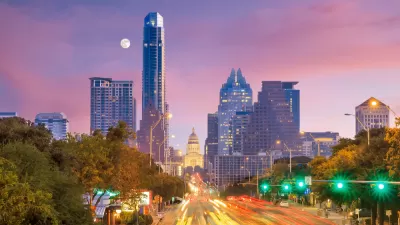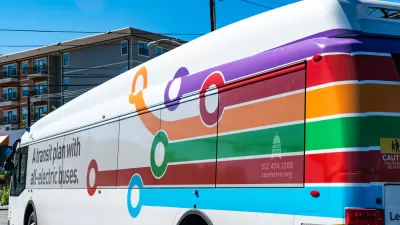A $7 billion transit investment plan for Austin would include $300 million toward preventing displacement of communities in neighborhoods located near planned transit investments.

"The Austin City Council voted [in July] afternoon to move forward with plans to seek a property tax increase to help fund Project Connect, a plan to build more train and bus lines," reports Samuel King for KUT, Austin's NPR station.
Voters would still have to approve the property tax if the proposal makes it all the way through the City Council process. "The tax increase of 8.75 cents per $100 of property valuation would fund a $7 billion initial expansion of the transit system, as opposed to a higher tax rate of 11 cents that would have funded the full system plan of $10 billion. The council will formally vote next month on whether to put the plan to voters in a November referendum," explains King.
Another big contingency for the plan is funding from the federal government to match the local investment. If the new property tax is approved by voters, the federal government would still be expected to cover 45 percent of the $7 billion plan.
The new revenue generated by the property tax would also include funding for programs intended to mitigate displacement as a result of new development spurred by the city's transit investments. "The plan now calls for a $300 million fund to address displacement, up from $100 million," reports King.
FULL STORY: Austin City Council Wants To Help Prevent People From Getting Priced Out If New Transit Is Built

Study: Maui’s Plan to Convert Vacation Rentals to Long-Term Housing Could Cause Nearly $1 Billion Economic Loss
The plan would reduce visitor accommodation by 25,% resulting in 1,900 jobs lost.

North Texas Transit Leaders Tout Benefits of TOD for Growing Region
At a summit focused on transit-oriented development, policymakers discussed how North Texas’ expanded light rail system can serve as a tool for economic growth.

Why Should We Subsidize Public Transportation?
Many public transit agencies face financial stress due to rising costs, declining fare revenue, and declining subsidies. Transit advocates must provide a strong business case for increasing public transit funding.

How Community Science Connects People, Parks, and Biodiversity
Community science engages people of all backgrounds in documenting local biodiversity, strengthening connections to nature, and contributing to global efforts like the City Nature Challenge to build a more inclusive and resilient future.

Alabama: Trump Terminates Settlements for Black Communities Harmed By Raw Sewage
Trump deemed the landmark civil rights agreement “illegal DEI and environmental justice policy.”

Dear Tesla Driver: “It’s not You, It’s Him.”
Amidst a booming bumper sticker industry, one writer offers solace to those asking, “Does this car make me look fascist?”
Urban Design for Planners 1: Software Tools
This six-course series explores essential urban design concepts using open source software and equips planners with the tools they need to participate fully in the urban design process.
Planning for Universal Design
Learn the tools for implementing Universal Design in planning regulations.
City of Santa Clarita
Ascent Environmental
Institute for Housing and Urban Development Studies (IHS)
City of Grandview
Harvard GSD Executive Education
Toledo-Lucas County Plan Commissions
Salt Lake City
NYU Wagner Graduate School of Public Service




























